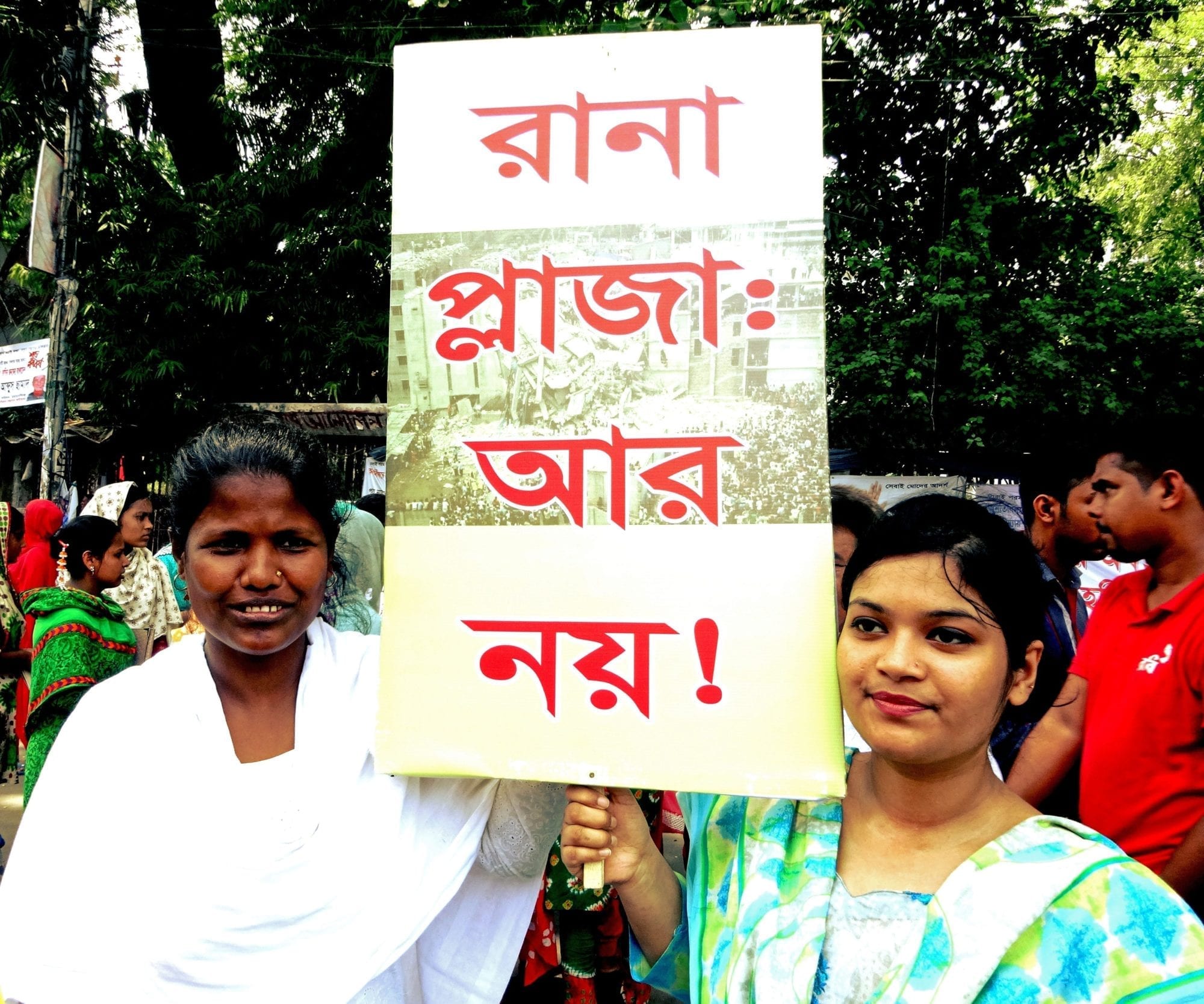
Apr 26, 2016
Meherunnesa joined the crowds gathered in Dhaka over the weekend to commemorate the third anniversary of the Rana Plaza building collapse in Bangladesh. Her son, Abul Kalam Azad, was one of the more than 1,100 garment workers killed on April 24, 2013, as the multi-story building pancaked in a preventable accident that also left thousands severely injured. Meherunnesa, 70, travels 150 miles from her home in Satkhira, in southwest Bangladesh each year to honor him.
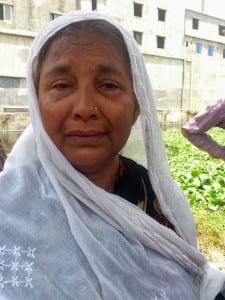
Meherunnesa, 70, lost her son in the 2013 Rana Plaza collapse. Credit: Solidarity Center
Across the city, garment workers and their allies took part in a series of actions, starting off with a wreath-laying in memory of those killed. Later, hundreds of garment workers formed a human chain at the Press Club to demand punishment for those responsible for the building’s collapse and press for social security insurance so that in the future, workers and their families can be compensated for workplace injuries and death. They were joined by members of the global union IndustriAll, Sramik Nirapotta Forum, the Solidarity Center and other allies.
Anisur Rahman is among those injured at Rana Plaza who says he never received compensation. Anisur was a maintenance worker on the building’s seventh floor when it collapsed. He survived a broken neck injury and now suffers from memory loss. He has been unable to get another job because of his injuries, but says he has not given up.
International outrage over the Rana Plaza and Tazreen disasters prompted creation of the Bangladesh Fire and Building Safety Accord process, a legally binding agreement in which nearly 200 corporate clothing brands pay for garment factory inspections. Dozens of garment factories have been closed for safety violations and pressing safety issues addressed.
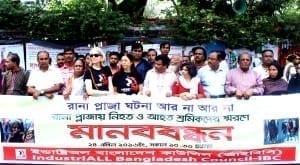
Garment workers and their allies formed a human chain at the Press Club in Dhaka, part of events commemorating the 2013 Rana Plaza collapse. Credit: Solidarity Center
Since the Tazreen fire, 34 garment workers have been killed in fire incidents and 1,023 workers injured, according to data compiled by the Solidarity Center staff in Bangladesh.
Further, workers seeking to form unions to improve workplace safety have encountered increasing obstacles in doing so. Since January 2015, government approval of union registrations has dropped precipitously: In 2015, the government rejected 73 percent of union registration applications, according to data compiled by Solidarity Center staff in Dhaka. Rejections of workers’ desire to organize continues in 2016.
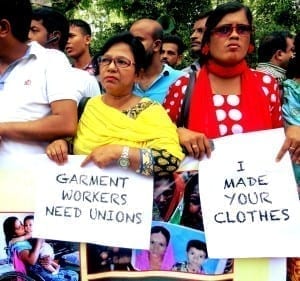
Garment workers increasingly face obstacles to forming unions and getting safety on the job. Credit: Solidarity Center
Citing “persistent and growing violations by the Bangladesh government of its responsibility to respect workers’ rights,” the International Trade Union Confederation (ITUC) filed a freedom of association case with the International Labor Organization (ILO).
According to the ITUC, the case, which will be heard by the ILO’s Committee on Freedom of Association, “details how the government … sought the dissolution of existing unions and stood idly by when factory management have engaged in union-busting in contravention of the Bangladesh Labor Act and criminal law.” The details include examples of union leaders who have been beaten and hospitalized and members of union executive boards who have been fired.
Over the past few years, the Solidarity Center has held fire safety trainings for hundreds of garment factory workers. Workers learn fire prevention measures, find out about safety equipment their factories should make available and get hands-on experience in extinguishing fires.
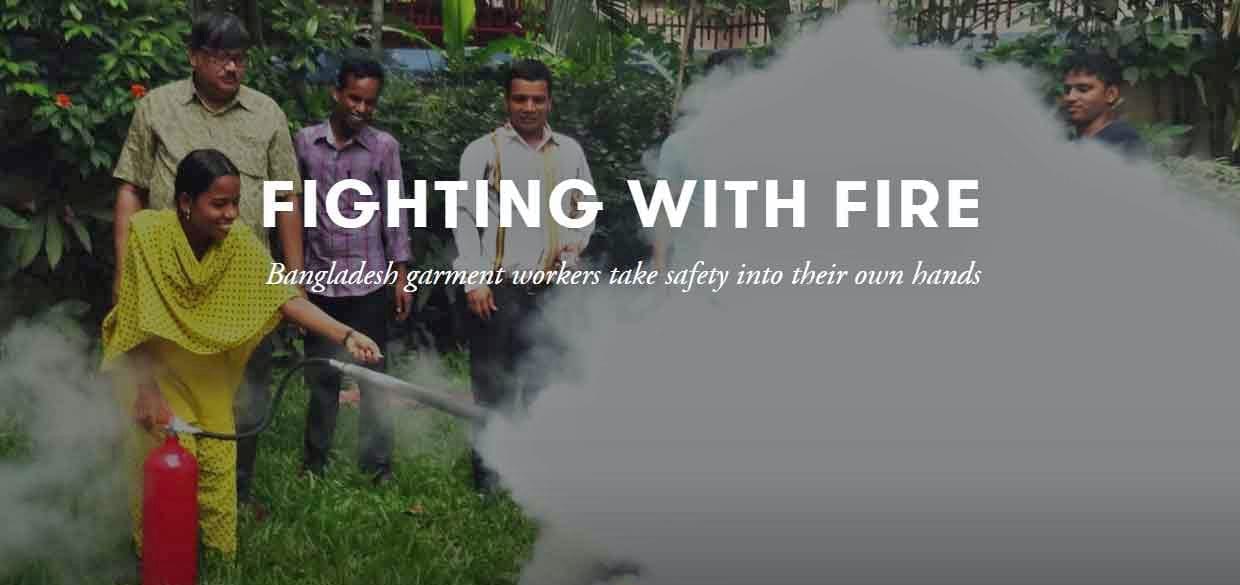
Apr 22, 2016
Three years after the deadly Rana Plaza building collapse killed more than 1,100 garment workers in Bangladesh, Solidarity Center safety training is helping empower workers to take safety into their own hands.
A new Solidarity Center photo essay shows how garment workers, union leaders and factory management learn about fire and building safety codes and preventative measures, and practice steps to take in an emergency.
Some 176 union leaders have completed the Solidarity Center’s Fire and Building Safety 10-week certification program, putting 62 Bangladesh garment factories on a path towards safer working conditions. The Solidarity Center has held nine 10-week intensive training courses on fire and building safety.
See the full photo essay.
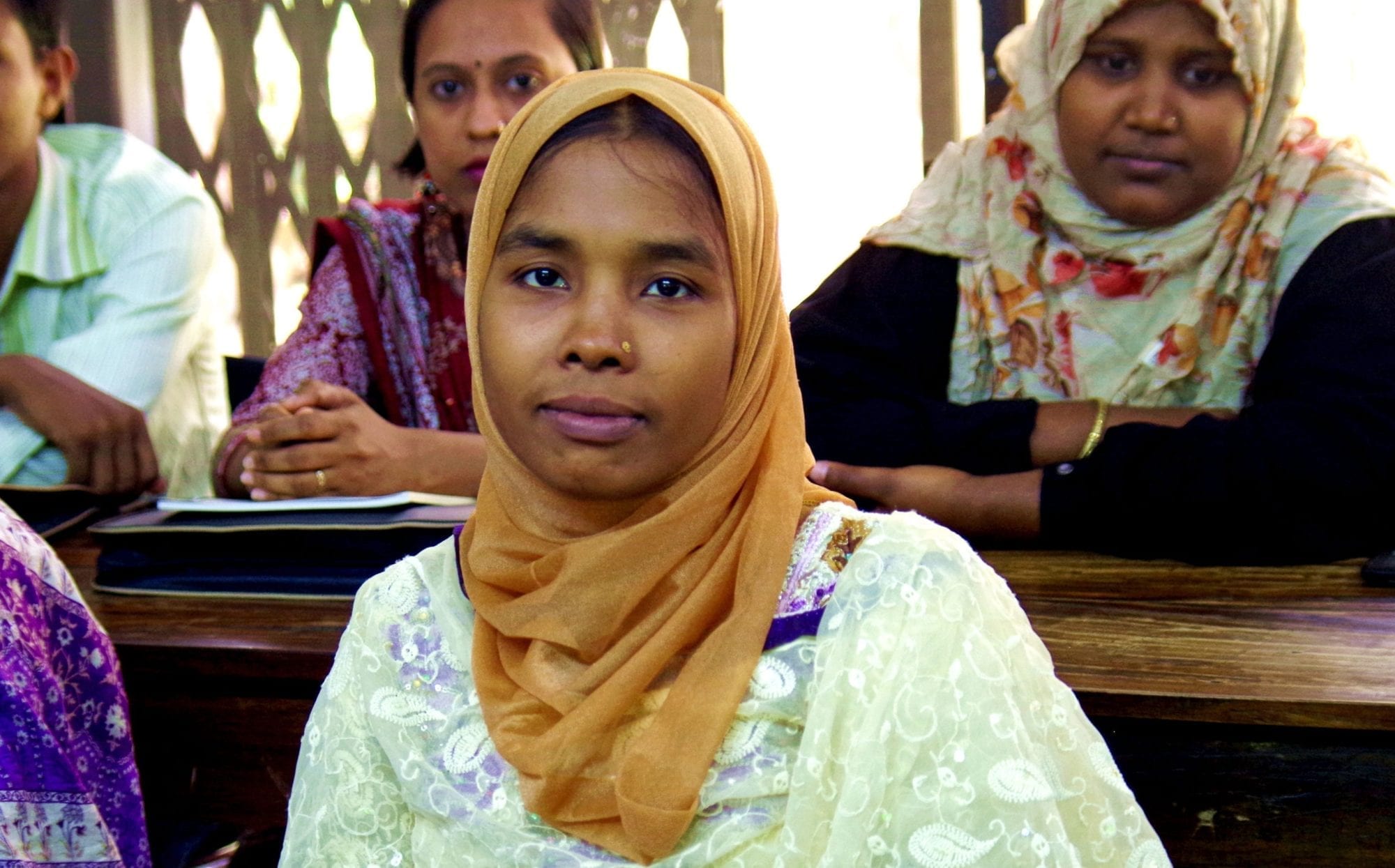
Apr 21, 2016
More than 1,100 garment workers died April 24, 2013, when the Rana Plaza building collapsed in Bangladesh, a preventable disaster that injured thousands more workers in the world’s worst industrial accident in years.
Yet their lives likely would have been spared “if any of the factories (in the building) had a union,” says union leader Salma Akter Meem. Salma made her observation as she took part this month in a 10-week-long Solidarity Center fire safety training program, one of nearly a dozen such programs the Solidarity Center has held in the past two years.
Salma, 26, started working at age 14 in the garment industry. She says the Rana Plaza building collapse made her co-workers aware of safety issues, and they formed a union September 2013 so they could have a collective voice to create positive changes in their workplace, including making their factory safe.
Blocked from Factory for Trying to Form a Union
Forming a union was not easy, she says. The employer refused to recognize their union even after it received official government registration, which is required in Bangladesh. Employers retaliated against union members, especially against workers on the factory union’s executive committee, Salma says.
“I was harassed and my union members were banned from entering the factory while we raised our voices and brought attention to the Accord that there was excessive machinery load on the floor and safety issues,” says Salma, who now is general secretary of the factory union.
The Bangladesh Fire and Building Safety Accord, a legally binding agreement in which nearly 200 corporate clothing brands paid for garment factory inspections, was set up after international outrage over the Rana Plaza and the Tazreen Fashions Ltd. tragedy five months earlier, in which more than 100 garment workers were killed when the factory burned down. Since the Tazreen fire, 34 garment workers have been killed in fire incidents and 1,023 workers injured, according to data compiled by the Solidarity Center staff in Bangladesh, according to data compiled by the Solidarity Center in Dhaka, the capital.
Following inspections mandated by the Accord, dozens of garment factories were closed for safety violations and pressing safety issues were addressed.
Standing Strong Together and Winning
Even though some workers were not allowed to work after they formed a union, Salma and her co-workers did not give up in the face of such employer resistance. With assistance of the Solidarity Center and the Bangladesh Garment and Industrial Workers Federation (BGIWF), to which their factory union is affiliated, workers got their jobs back with full compensation for the time they were prevented from working.
Negotiations and discussions with management, finalized in February 2015, have resulted in positive changes, Salma says, with workers getting a wage increase, maternity benefits and safe drinking water. The factory now is clean, has adequate fire extinguishers on every floor, and a fire door has replaced a collapsible gate.
“Changes are possible if you have union and you can make it work.”
Back at the Fire and Building Safety class, Salma says she is “learning here not only for me, but also for my factory and family.” She says if workers are safe in a factory and not afraid to raise their voices for a safe and healthy work environment and living wages to support themselves, their workplace contributions will increase, benefiting the employer—and the country.
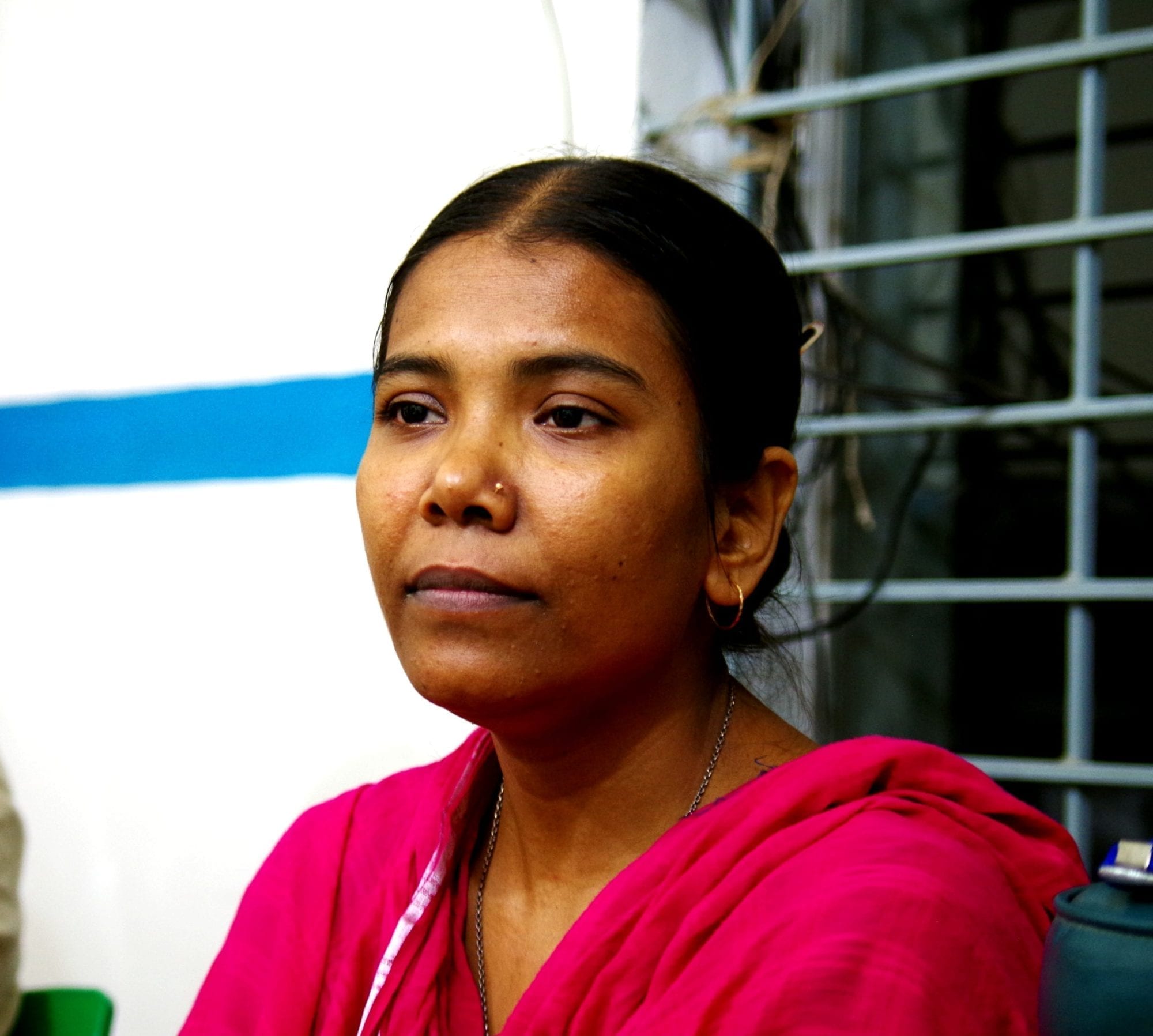
Apr 20, 2016
In Dhaka, Bangladesh, the conditions Sharina describes at the garment factory where she works can be summed up in three words: dangerous, unsanitary and exploitative. Wages are delayed. Legally required maternity leave is denied. Workers are sometimes forced to toil until 3 a.m. and are fired if they refuse. Bathroom facilities are so appalling workers have difficulty focusing on work because of the odor.
Sharina (not her real name) says her co-workers do not speak out about these issues, nor do they point out potentially hazardous electrical problems to their employer because they fear they will be fired. And each day, workers put their health and safety on the line because they have received no safety training and no safety protections.
In fact, says Sharina, 30, only when safety inspectors show up do managers distribute safety equipment like rubber boots, gloves and masks to workers, and put needle safety guards on sewing machines.
“Things would be better if we had a union,” says Sharina, 30. Workers could negotiate with management to receive safety training and avoid deadly tragedies, she says, adding that the more than 1,130 garment who died and the thousands who were injured in the Rana Plaza building collapse on April 24, 2013, would not have had to risk their lives for their jobs if they had been able to join together in a union and collectively push for safe working conditions. With a union, workers have the protection they need against being fired when standing up for improvements at work.
Solidarity Center staff interviewed Sharina, who has worked at the factory since 2012, on the eve of the third anniversary of the Rana Plaza disaster. The tragedy closely followed the November 2012 fire at the Tazreen Fashions factory that killed more than 112 Bangladesh garment workers and injured hundreds more.
Following the two disasters, the United States in June 2013 suspended its Generalized System of Preferences (GSP) agreement with Bangladesh based upon chronic and severe labor rights violations. Soon after, the Bangladesh government accepted union registrations with increasing frequency as workers organized and formed unions to address safety problems and low wages. (When workers forms unions, the Bangladesh government requires workers to register their unions before they are officially recognized.)
But after reaching a peak in January 2015, government approval of union registrations has dropped precipitously: In 2015, the government rejected 73 percent of union registration applications, according to data compiled by Solidarity Center staff in Dhaka. Rejections of workers’ desire to organize continues in 2016.
International outrage over the Rana Plaza and Tazreen disasters also prompted creation of the Bangladesh Fire and Building Safety Accord process, a legally binding agreement in which nearly 200 corporate clothing brands pay for garment factory inspections. Dozens of garment factories have been closed for safety violations and pressing safety issues addressed.
Since the Tazreen fire, 34 garment workers have been killed in fire incidents and 1,023 workers injured, according to data compiled by the Solidarity Center staff in Bangladesh.
Over the past few years, the Solidarity Center has held fire safety trainings for hundreds of garment factory workers. Workers learn fire prevention measures, find out about safety equipment their factories should make available and get hands-on experience in extinguishing fires.
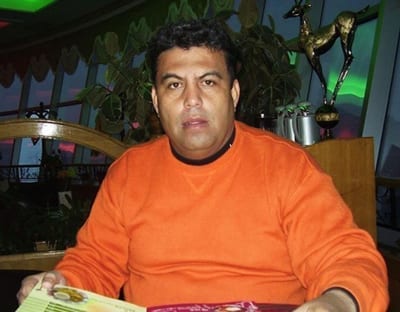
Apr 18, 2016
Since April 2015, at least 14 Honduran union leaders and members have suffered threats or violence, including one who was disappeared and another one who was murdered, part of a campaign of intimidation against worker rights documented in a new report by the Union Network against Anti-Union Violence in Honduras.
Days after the report’s release, Nelson Geovanni Núñez Chávez eceived renewed death threats for helping banana workers form unions, according to the Honduras-based nonprofit ACI-Participa. Last November, Núñez Chávez was forced to leave his home with his family after repeatedly being followed and harassed.
Nuñez Chavez is an organizer for the Honduran agricultural workers’ union, Sindicato de Trabajadores de la Agroindustria y Similares (STAS), and host of the radio program, “Unionist on the Air.”
Four of the 14 union members and leaders who were victims of violence were active in the Network against Anti-Union Violence—a trend Honduran human rights activists say is a troubling development that may indicate those who actively seek justice for perpetrators of violence are targeted for attack.
Héctor Martínez Motiño, president of a local sectional union of Workers of the National Autonomous University of Honduras (SITRAUNAH), was murdered in June despite protection from the Inter-American Commission on Human Rights (IACHR). Environmental activist Berta Cáceres Flores, who was murdered last month in Honduras, also had IACHR protection. Observers say there was no police presence around either Martínez Motiño or Cáceres when they were killed. ACI-Participa has documented the assassination of 13 recipients of precautionary measures.
Two union leaders also faced death threats as they defended worker rights at agro-industrial plantations cited in a 2012 complaint filed by the AFL-CIO and 26 Honduran unions and civil society organizations over the Central American Free Trade Agreement (CAFTA). The complaint alleges the Honduran government failed to enforce labor rights under its labor laws.
A report released yesterday by an international fact-finding commission, “Justice for Berta Cáceres Flores,” cited the “ineffectiveness of the Honduran state’s human rights protection system, as well as a prevailing institutional practice that ignores the rights of the victims of human rights violations as active rights holders.”
Honduras passed a law six months ago that protects human rights defenders, but has not issued a regulation on its implementation or enforcement.
The Network against Anti-Union Violence in Honduras, a Solidarity Center ally, was created in 2014 to document violence against union members and push for an end to impunity for those who commit such crimes. No formal statistics on violence against trade unionists existed before the network formed.








